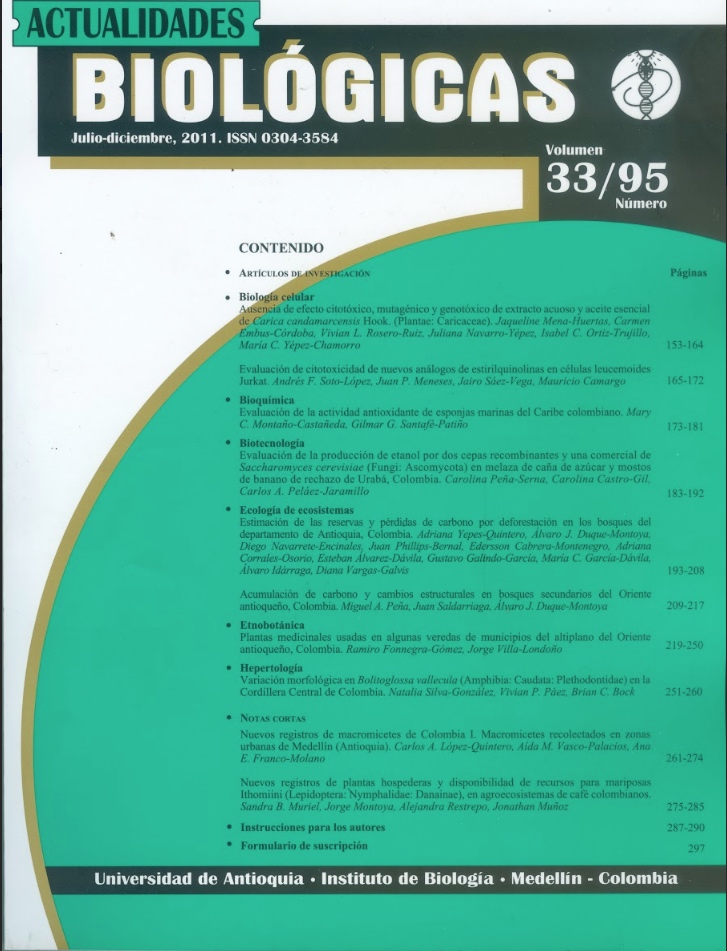Cytotoxicity evaluation of new styrylquinoline analogues In leukemoid Jurkat cells
DOI:
https://doi.org/10.17533/udea.acbi.14292Keywords:
Jurkat, leukemia, MTT, S9 styrylquinoline, viabilityAbstract
Some of the most commonly used and effective drugs used in antileukemic treatments posses principal chemical structures with quinoline rings and/or styrene groups, which might suggest that analogous compounds may serve as potential new antiproliferative agents. Recently, one of our laboratories synthesised six new styrylquinoline analogues as candidates for having antiproliferative and/or anti-cancer effects. Thus, using the MTT assay we evaluated the cytotoxicity of these six compounds in the leukemoid cell line Jurkat. The results showed an absence of cytotoxic effects at the concentrations and times assayed. In addition, when the treatments were applied in the presence of S9 microsomal fraction, cell viability was not altered in this leukemoid in vitro model. These results open the possibility of evaluating these styrylquinolines in other cell lines or diseases models with the goal of examining promising biomedical effects.
Downloads
References
Cortes JE, Kantarjian HM. 1995. Acute lymphoblastic leukemia. Cancer, 76 (12): 2393-2417. DOI: https://doi.org/10.1002/1097-0142(19951215)76:12<2393::AID-CNCR2820761203>3.0.CO;2-P
Danizot F, Lang R. 1986. Rapid colorimetric assay for cell growth and survival. Modifications to the tetrazolium dye procedure giving improved sensitivity and reliability. Journal of Immunological Methods, 89 (2): 271-277. DOI: https://doi.org/10.1016/0022-1759(86)90368-6
Hirano Y, Uehara M, Saeki K, Kato T, Takahashi K, Miztutani T. 2002. The influence of quinolines on coumarine 7-hydroxylation in bovine liver microsomes and human CYP2A6. Journal of Health Sciences 48 (2): 118-125.
Hranjec M, Kralj M, Piantanida I, Sedic M, Suman L, Pavelic K, Karminski-Zamola G. 2007. Novel cyano- and amidino-substituted derivatives of styryl-2- benzimidazoles and benzimidazo [1, 2-a] quinolines. Synthesis, photochemical synthesis, DNA binding, DOI: https://doi.org/10.1021/jm070876h
and antitumor evaluation, part 3. Journal of Medicinal Chemistry, 50 (23): 5696-5711.
Kaspers GJ, Veerman AJ, Pieters R, Van Zantwijk CH, Smets LA, Van Wering ER, Van Der Does-Van Den Berg A. 1997. In vitro cellular drug resistance and prognosisin newly diagnosed childhood acute lymphoblastic leukemia. Blood, 90 (7): 2723-2729. DOI: https://doi.org/10.1182/blood.V90.7.2723
Kim Y, Shin K, Lee T, Kim E, Lee M, Ryu S, Suh P. 2005. G2 arrest and apoptosis by 2-amino-N-quinoline-8-yl-benzenesulfonamide (QBS), a novel cytotoxic compound. Biochemical Pharmacology, 69 (9): 1333-1341. DOI: https://doi.org/10.1016/j.bcp.2004.12.019
Knasmüller S, Majer BJ, Kassie F, Sasaki Y, Pfauc W, Glatt H, Meinl W, Darroudi F. 2004. Investigation of the genotoxic effects of 2-amino-9H-pyrido[2,3-b]indole in different organs of rodents and in human derived cells. Journal of Chromatography B, 802 (1): 167-173. DOI: https://doi.org/10.1016/j.jchromb.2003.10.042
Lebsanft J, McMahon JB, Steinmann GG, Shoemaker RH. 1989. A rapid in vitro method for the evaluation of potential antitumor drugs requiring metabolic activation by hepatic s9 enzymes. Biochemical Pharmacology, 38 (24): 4477-4483. DOI: https://doi.org/10.1016/0006-2952(89)90659-X
Lee E, Min H, Park H, Chung H, Kim S, Han Y, Lee S. 2004. G2/M cell cycle arrest and induction of apoptosis by a stilbenoid, 3, 4, 5-trimethoxy-4’-bromo-cis-stilbene, in human lung cancer cells. Life Sciences, 75 (23): 2829-2839. DOI: https://doi.org/10.1016/j.lfs.2004.07.002
Martirosyan AR, Rahim-Bata R, Freeman AB, Clarke CD, Howard RL, Strobl JS. 2004. Differentiation-inducing quinolines as experimental breast cancer agents in the MCF-7 human breast cancer model. Biochemical Pharmacology, 68 (9): 1729-1738. DOI: https://doi.org/10.1016/j.bcp.2004.05.003
MusiolR,Jampilek J,KralovaK,RichardsonDR,Kali•nowski D, Podeszwa B, Finster J, Niedbala H, Palka A, Polanski J. 2007. Investigating biological activity spectrum for novel quinoline analogues. Bioorganic and Medicinal Chemistry, 15 (3): 1280-1288. DOI: https://doi.org/10.1016/j.bmc.2006.11.020
Reigh G, McMahon H, Ishizaki M, Ohara T, Shimane K, Esumi Y, Green C, Tyson C, Ninomiya S. 1996. Cytochrome P450 species involved in the metabolism of quinoline. Carcinogenesis 17 (9): 1989-1996. DOI: https://doi.org/10.1093/carcin/17.9.1989
Soto-Cerrato V, Montaner B, Martinell M, Vilaseca M, Giralt E, Pérez R. 2005. Cell cycle arrest and proapoptotic effects of the anticancer cyclodepsipeptide serratamolide (AT514) are independent of p53 status in breast cancer cells. Biochemical Pharmacology, 71 (1-2): 32-41. DOI: https://doi.org/10.1016/j.bcp.2005.10.020
Vezmar M, Georges E. 2000. Reversal of MRP-mediated doxorubicin resistance with quinoline-based drugs. Biochemical Pharmacology, 59 (10): 1245-1252. DOI: https://doi.org/10.1016/S0006-2952(00)00270-7
Vieira NC, Herrenknecht C, Vacus J, Fournet A, Bories C, Figadere B, Espindola LS, Loiseau PM. 2008. Selection of the most promising 2-substituted quinoline as antileishmanial candidate for clinical DOI: https://doi.org/10.1016/j.biopha.2008.09.002
trials. Biomedicine and Pharmacotherapy, 62 (10): 684-689.
Volkova T, Zykina N, Malycheva I, Nemova N. 2007. Cell mechanisms for apoptosis induction in K562 human erythroleukemia cell line treated with quinoline-N-oxide derivatives. Biochemistry (Moscow) Supplemental Series B: Biomedical Chemistry, 1 (1): 82-86. DOI: https://doi.org/10.1134/S199075080701012X
Yoshie H, Mayumi U, Ken-ichi S, Taka-aki K, Kazuhiko T, Takaharu M. 2002. The influenze of quinolines on coumarin 7-hydroxylation in bovine liver microsomes and human CYP2A6. Journal of Health Sciences, 48 (2): 118-125. DOI: https://doi.org/10.1248/jhs.48.118
Zhang H, Kasibhatla S, Wang Y, Herich J, Guastella, J, Tseng B, Drewe J, Cai S. 2004. Discovery, characterization and SAR of gambogic acid as a potent apoptosis inducer by a HTS assay. Bioorganic and Medicinal Chemistry, 12 (2): 309-317. DOI: https://doi.org/10.1016/j.bmc.2003.11.013
Downloads
Published
How to Cite
Issue
Section
License
The authors exclusively authorize the Actualidades Biológicas journal to edit and publish the submitted manuscript if its publication is recommended and accepted, without this representing any cost to the Journal or the University of Antioquia.
All the ideas and opinions contained in the articles are sole responsibility of the authors. The total content of the issues or supplements of the journal is protected under the Creative Commons Attribution-NonCommercial-ShareAlike 4.0 International License, so they cannot be used for commercial purposes, but for educational purposes. However, please mention the Actualidades Biológicas journal as a source and send a copy of the publication in which the content was reproduced.












